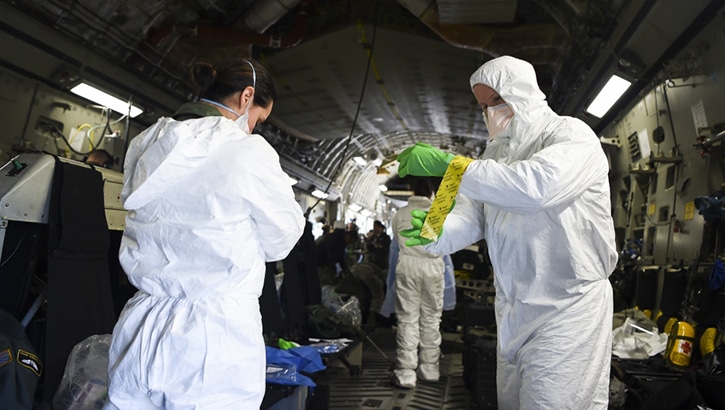Updated 20 April 2020. Trump’s war on the World Health Organization has just taken a new twist. News has emerged that the Trump administration received full information in real-time from Americans working at WHO, undercutting Trump’s accusations that the WHO had failed to inform. Here is what the Washington Post reported on 19 April:
“More than a dozen U.S. researchers, physicians and public health experts, many of them from the Centers for Disease Control and Prevention, were working full time at the Geneva headquarters of the World Health Organization as the novel coronavirus emerged late last year and transmitted real-time information about its discovery and spread in China to the Trump administration, according to U.S. and international officials.”
Yesterday, Tuesday 14 April, Trump all but declared war on the World Health Organization (WHO). He accused it of “severe mismanaging” and “covering up the spread of the coronavirus”.
The day before, on Monday 13 April, Trump used the daily coronavirus briefing as an election campaign-style spot, to blame everyone, Obama, Democrats, the media and the WHO for his own mismanagement and delays in addressing the pandemic. He even presented a White House-produced campaign-style reel of selected video clips showing officials effusively praising his efforts.
But 14 April marked a turning point. He doubled down on his attack, announcing that his administration would halt funding for the WHO and claiming the organization made a series of “devastating mistakes” in handling the pandemic and that it did so at the bidding of China This despite the fact that he himself covered China with praise as early as Jan. 24, about a month after the virus was discovered there. He tweeted:
China has been working very hard to contain the Coronavirus. The United States greatly appreciates their efforts and transparency. It will all work out well. In particular, on behalf of the American People, I want to thank President Xi!
— Donald J. Trump (@realDonaldTrump) January 24, 2020
Trump even sent 18 tons of PPEs (personal protective equipment – masks, gowns, and respirators) to China on 7 February, PPEs that were never replenished. That happened on the very day WHO warned about the limited stock of PPEs.
Why this Trumpian attack on WHO?
The reason is easy to discover: His plunging poll numbers, as most Americans became displeased with the way Trump handled the emergency. So Trump did what he knows best, look for scapegoats to hide his own incompetence and dilly-dallying. On April 7, he blasted the WHO for the first time, as usual, with a tweet blaming WHO for being “very China centric”:
The W.H.O. really blew it. For some reason, funded largely by the United States, yet very China centric. We will be giving that a good look. Fortunately I rejected their advice on keeping our borders open to China early on. Why did they give us such a faulty recommendation?
— Donald J. Trump (@realDonaldTrump) April 7, 2020
And later, on the same day, at the coronavirus briefing, he repeated his accusations, falsely alleging that the WHO had called the initial Wuhan outbreak “no big deal”, adding that they “called it wrong… they missed the call. And we’re going to put a hold on money spent to the WHO.”
And that is what the Trump administration is now doing. It is holding up WHO funding.
Consider that even before COVID-19 came along, the Trump Administration had requested a 50% reduction in the U.S.assessed financial contributions to the WHO from $122.6 million to an assessed contribution of $57.9 million.
Just to set the record straight. Consider the line of events.
On 31 December, the WHO first moved on COVID-19, when the Chinese government, with an undoubtedly morally unacceptable delay, finally decided to alert it to the situation in Wuhan. By 7 January, WHO confirmed a novel coronavirus.
On 12 January, the WHO obtained the entire genome – essential to construct effective testing procedures. Nine days later, the first WHO scientific team landed in Wuhan.
On Jan. 30, the WHO officially declared the epidemic a “public health emergency of international concern” (PHEIC).
On 31 March, Trump declared it a national emergency for the US.
He lost practically two months. As noted by WPR and others in the media, WHO did make some early errors, including the infamous Jan. 14 tweet that Chinese authorities had found “no clear evidence of human-to-human transmission.” But these errors were corrected as information and epidemiological data accumulated.
Michael Shear in the New York Times sums it up nicely:
“In fact, the W.H.O. sounded the alarm in the earliest days of the crisis, declaring a “public health emergency of international concern” a day before the United States secretary of health and human services announced the country’s own public health emergency and weeks before Mr. Trump declared a national emergency.”
Be that as it may, Trump’s attack on WHO found immediate Republican support on Capitol Hill. Republican Sen. Lindsay Graham of South Carolina, chair of the Senate’s appropriations subcommittee, warned, “I’m not going to support funding under [WHO’s] current leadership. They’ve been deceptive, they’ve been slow, and they’ve been Chinese apologists.” Sen. Rick Scott (R-Fla.) called for a congressional inquiry into WHO, accusing the Organization of assisting in a China “cover-up”.
Unfortunately, as Stewart M. Patrick, a policy expert on the Council of Foreign Relations noted in a recent WPR article, Trump, in attacking the WHO, is simply taking advantage of the fact that, among his supporters, “the struggle between “nationalists” and “globalists” [is seen] as the defining foreign policy battle of our age” .
A meme supported by populist leaders everywhere, from Bolsonaro in Brazil, Matteo Salvini in Italy to Marine Le Pen in France and, of course, Trump’s former mentor, Steve Bannon.
What all this amounts to is yet another attempt by Trump to destroy the world order the United States built after World War II.
Health experts have long recognized that a pandemic such as COVID-19 was to be expected and on Impakter we talked about this issue repeatedly, most recently in an article assessing the state of world preparedness (or lack of it) in a world traumatized by Trump’s America First agenda.
COVID-19 did not strike out of the blue. It came on the heels of SARS, MERS, H1N1, Ebola, all major outbreaks in the last fifteen years.
Following the SARS outbreak in 2003, the World Health Organization strengthened the global framework for responding to outbreaks. Admittedly with uneven results as WHO member countries went each their own way, reluctant to fund the organization fully and to follow recommendations. All in the name of national independence.
WHO did receive support from other organizations in the UN system. Notably, in 2016, the World Bank launched a Pandemic Emergency Financing Facility to support low-income countries.
Yet, it’s not as if Trump had no advance warning. Just a few months before COVID-19 exploded in Wuhan, China, a US government report cautioned the Trump administration about the likelihood of a flu pandemic on the scale of the Spanish flu that killed an estimated 50 million people worldwide. A warning that was lost on a man who distrusts science and only trusts his own “intuition”.
We will never know exactly when Trump was first briefed, possibly as early as November last year, when U.S. intelligence officials were reportedly warning that a mysterious contagion was sweeping through China’s Wuhan region. The complex relations with China over trade negotiations caused Trump to overlook this news.
Yet, starting in January, he received many warnings from members of his cabinet. Notable are the two briefings from Alex Azar, one on 18 January, the other on January 30. Azar, a former pharmaceutical lobbyist and executive, is his Secretary of Health. The president believed he was “alarmist.”
His instinct for firing people and his distrust of scientific expertise and government resulted in a series of delays, bungled decision-making and refusal to use Federal authority to coordinate state responses. The US did not request test kits made available by the WHO, and failed to produce reliable tests early on. As we all know, hospitals and state authorities were forced to compete against one another to secure supplies.
When Trump was first asked publicly about the virus, on Jan. 22, he famously stated, “We have it totally under control. It’s one person coming in from China…It’s going to be just fine.”
On Feb. 10, Trump reassured supporters at a rally in New Hampshire, “Looks like by April, you know, in theory, when it gets a little warmer, it miraculously goes away.” At a Feb. 26 news conference, he explained, “This is a flu. This is like a flu.” On March 9, as the death count rose and could no longer be ignored, he tried another tactic: “This blindsided the world,” he alleged. “And I think we’ve handled it very, very well.”
In short, Trump spoke at eight rallies and golfed six times before he declared a national emergency on March 31.
By that time, as we all know now, it was too late.
At the time of writing, coronavirus cases have exceeded 2 million, and deaths approach 130,000. The country worst hit by the coronavirus is the United States, with over 600,000 cases and 26,000 deaths – numbers that, according to the experts, are probably considerably under the real extent of the catastrophe.
Featured Image: Airmen assist one another in donning their personal protective equipment (PPE), while on-board an Air Force C-17 Globemaster III during transportation isolation system training at Joint Base Charleston, South Carolina. Engineered and implemented after the Ebola virus outbreak in 2014, the TIS is an enclosure the Department of Defense can use to safely transport patients with diseases like novel coronavirus. (U.S. Air Force photo by Senior Airman Cody R. Miller) Source: MHS 6 Feb. 2020









